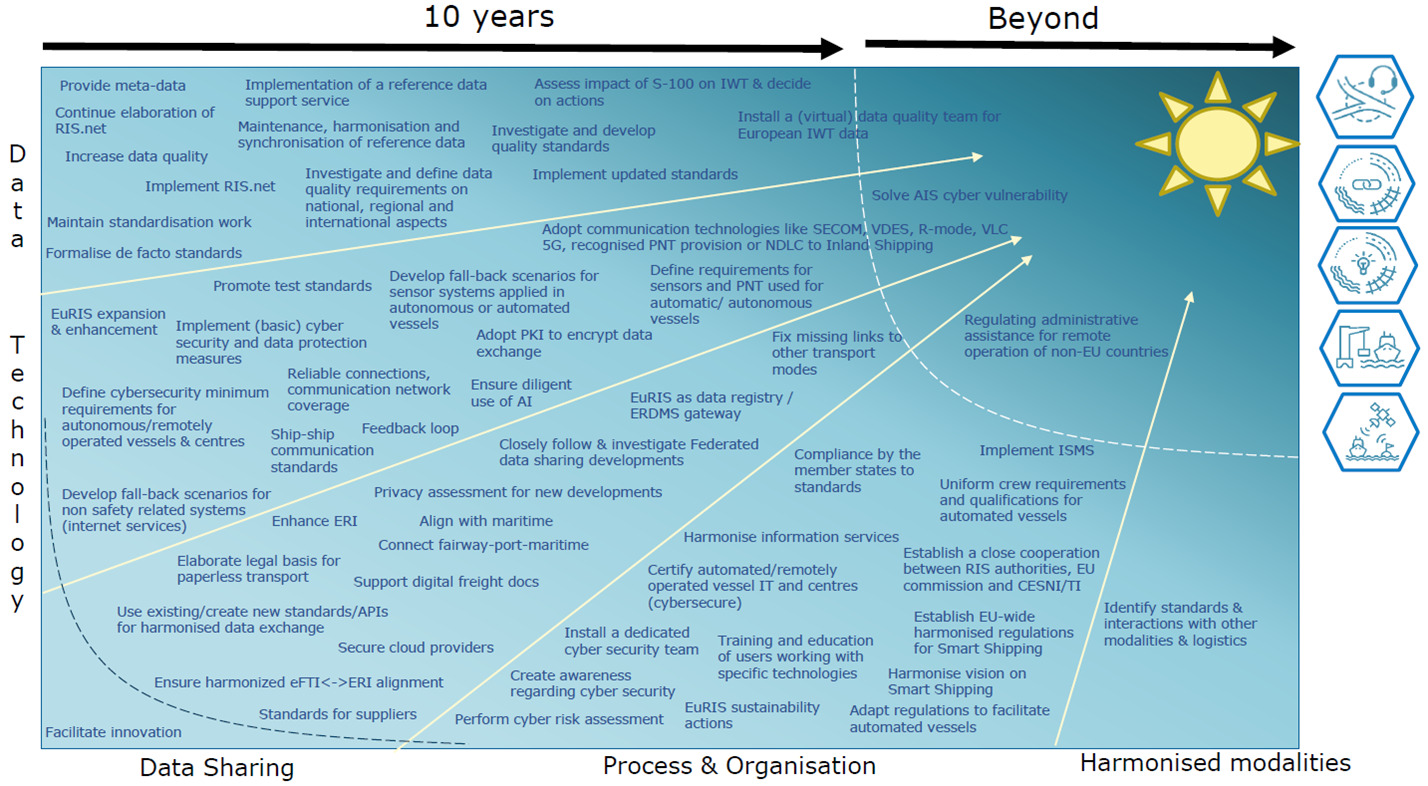A successful digitalisation in Inland Waterway Transport (IWT) is facilitated by proactive standardisation, visionary rules and regulations, advanced cybersecurity and a high data quality. Indeed, good (frameworks for) standards can facilitate a swift digitalisation, just as the lack thereof can be a serious impediment for digitalisation. The same goes for rules and regulations as they can cause a significant hindrance for digital evolutions if written solely considering the paradigm of a skipper on a vessel carrying cargo and showing paper documents wherever needed. Even if most rules and regulations embrace the idea of digitalisation in all its aspects, a single ‘analogue’-oriented rule or regulation can slow down or even block important evolutions. Cybersecurity is essential for ensuring the safe and secure digitalization of inland waterway transport. By implementing appropriate cybersecurity measures, the sector can reap the benefits of digital technologies while minimizing the risks associated with cyber threats. Digital evolutions can only be successful if the received and provided data has sufficiently high quality and the necessary processes are implemented to safeguard this quality over time.
Four studies investigated the current state of play, possibilities and pitfalls for the future, and general ambition on these topics in light of the elaboration of a digitalisation masterplan for IWT in the period 2022 – 2032.
The main findings for each study are:
- 4.1 Standardisation
- Rapid technological developments and fast implementation of solutions required by the market are considered a challenge for the slower standardisation process. Several ‘de-facto’ standards on a technical level have already emerged. Standardisation is expected to close the missing links between IWT and other transport modes. As a precondition, data elements corresponding to paper forms must be harmonised between the modes. This harmonisation also includes reference data as location codes, which currently vary strongly between administrations & domains. Furthermore, coordinated maintenance procedures for reference data will become crucial for the data quality.
- 4.2 Legal & regulatory
- The digital transition and smart shipping in general encompass a variety of different technologies where each emerging technology initiates detailed technical questions. The subject of this sub activity is the existing laws of the EU and their compatibility with the new technologies and developments discussed in Act.2 Business developments and Act.3 Technological developments. Up to now, only partial areas have been regulated in the field of IWT. Legislators are challenged to enable the implementation of new technologies and create new legal structures for the use of those technologies. They must keep the fundamental freedoms of the European Union in mind and at the same time re-think previous principles such as the central responsibility of the shipmaster in (semi-) autonomous operations.
- 4.3 Cybersecurity & privacy
- Based on higher automation levels and the increase of information exchange and interconnections the surface for cyber-attacks increases as well. Consequently, cybersecurity standards and requirements are increasingly prominent on international agendas. Vulnerable technologies and a lack of awareness are still threatening transports in the IWT domain. To tackle these issues digital signing of messages, data encryption and Cyber secure by design are becoming the paradigm for new developments.
- 4.4 Data quality
- Data quality has an important role in data exchange and inland navigation as incorrect data can lead to damage to humans, material and the waterway infrastructure. Furthermore, data quality is seen as a crucial key factor for further technological developments as smart shipping, autonomous sailing, digital twins and Synchromodality are dependent on high data quality. Since a change in the purpose of data elements can fundamentally change the required data quality, the establishment of one framework as ‘the data quality framework for IWT’ is considered as untenable.
The main recommendations of the aforementioned studies are assessed, grouped into 5 overarching topics, and mapped on the general measures that were extracted from the other studies performed in the DIWA project. Where necessary new measures were added, or existing ones extended to ensure all recommendations concerning the facilitators were covered. The resulting measures are plotted on a ‘road to the sun’ , highlighting the time and roadmap component as a summarised output of this report.

As an overall conclusion, the main goal to reach in 10 years is a proactive stance of and a true, strong collaboration between the actors responsible for the different facilitators in IWT: standardisation, rules and regulations, cybersecurity, and data quality. If any of these facilitators fails to rise to the occasion this will seriously hamper, if not render impossible, the digitalisation goals in IWT for the upcoming decade.
